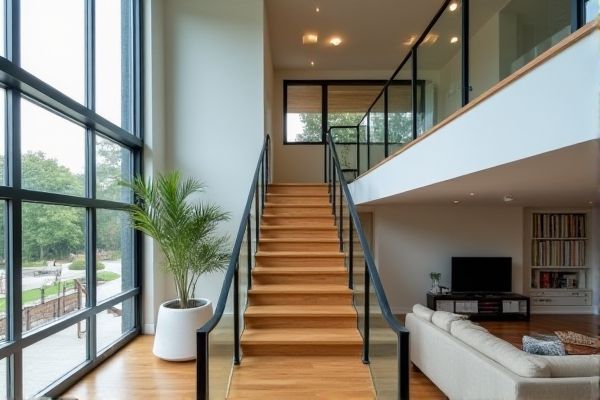
Steel railings offer unmatched durability and strength, making them ideal for long-lasting security and a sleek, industrial look. Explore the rest of the article to discover how your choice between steel and glass railings can enhance both safety and style in your space.
Table of Comparison
| Feature | Steel Railing | Glass Railing |
|---|---|---|
| Material | Stainless or carbon steel | Tempered or laminated glass with metal supports |
| Durability | High; resistant to impact and weather | Moderate; strong but can chip or crack |
| Maintenance | Requires periodic painting or rust prevention | Regular cleaning to maintain clarity |
| Safety | Strong and sturdy barrier | Safe if properly installed with tempered glass |
| Visibility | Opaque; blocks view | Transparent; offers clear sightlines |
| Aesthetics | Industrial and classic look | Modern and sleek appearance |
| Cost | Generally lower than glass | Higher due to material and installation |
| Installation | Simple with standard tools | Requires specialized installation |
Introduction to Steel and Glass Railings
Steel railings offer durability and a classic industrial look, made from materials like stainless steel or wrought iron that resist corrosion and provide strong structural support. Glass railings enhance aesthetics and visibility with tempered or laminated glass panels, creating a sleek, modern appearance while maintaining safety through robust mounting systems. Your choice between steel and glass railings depends on factors such as design preference, maintenance requirements, and the balance between transparency and sturdiness.
Aesthetic Appeal: Steel vs Glass Railings
Steel railings offer a sleek, industrial aesthetic characterized by bold lines and durability, ideal for modern or minimalist spaces seeking a strong visual statement. Glass railings provide a seamless, transparent look that maximizes natural light and creates an open, airy atmosphere, perfect for enhancing views and adding elegance. Your choice depends on whether you prioritize the solid, architectural presence of steel or the light, unobstructed appeal of glass in your design.
Durability and Strength Comparison
Steel railings offer exceptional durability and strength, with high resistance to impact, weather, and corrosion when properly treated, making them ideal for long-term outdoor use. Glass railings, while visually appealing and providing unobstructed views, rely on tempered or laminated glass that is strong but more susceptible to scratches, chips, and potential breakage under heavy impact. Your choice depends on the balance between structural robustness and aesthetic preference, with steel prioritizing strength and glass delivering modern transparency.
Safety Features of Steel and Glass Railings
Steel railings offer robust safety features, including high tensile strength and resistance to impact, making them ideal for securing balconies and staircases. Glass railings provide safety through tempered or laminated glass panels that are designed to withstand significant force and prevent shattering into sharp pieces. Both materials comply with international building codes and standards, ensuring reliable protection while enhancing aesthetic appeal.
Maintenance Requirements
Steel railings demand regular maintenance including rust prevention through painting or coating to ensure durability and safety. Glass railings require frequent cleaning to maintain their transparent aesthetic and prevent smudges or water stains from diminishing their appearance. Your choice depends on your willingness to perform routine upkeep or prefer a sleek, low-maintenance option.
Cost Analysis: Steel vs Glass Railings
Steel railings generally offer a more cost-effective solution compared to glass railings, with initial installation prices ranging from $50 to $150 per linear foot depending on design complexity and material quality. Glass railings can cost between $100 and $250 per linear foot due to higher material expenses and specialized installation requirements, but they provide a sleek, modern appearance that adds aesthetic value. Your decision should consider both upfront costs and long-term maintenance, as steel may require periodic painting or rust treatment while glass needs regular cleaning to maintain clarity.
Installation Process: What to Expect
Steel railing installation involves precise measurements, welding or bolting of components, and anchoring to concrete or wood surfaces, ensuring durability and strength. Glass railing installation requires securing tempered glass panels with sturdy clamps or posts, often using specialized hardware to maintain safety and aesthetics while allowing unobstructed views. Both systems demand professional expertise for proper alignment, stability, and compliance with building codes.
Design Flexibility and Customization Options
Steel railing offers exceptional design flexibility with its ability to be shaped into intricate patterns, customized finishes, and various color options, making it ideal for both traditional and modern aesthetics. Glass railing provides a sleek, minimalist look with customizable panel sizes, tints, and framing styles, enhancing visibility and creating an open, airy atmosphere. Your choice depends on whether you prioritize the bold, customizable strength of steel or the transparent elegance and adaptability of glass.
Environmental Impact and Sustainability
Steel railings offer high durability and recyclability, making them a sustainable choice with a lower environmental footprint if sourced from recycled materials. Glass railings, while providing aesthetic appeal and natural light enhancement, often involve higher energy consumption in production and transportation, impacting their overall sustainability. Choosing recycled or responsibly sourced steel minimizes environmental impact compared to the energy-intensive manufacturing processes for glass.
Choosing the Right Railing: Key Considerations
Choosing the right railing involves evaluating durability, maintenance, and aesthetic appeal, where steel railings offer robust strength and minimal upkeep, while glass railings provide modern elegance with a focus on visibility and openness. Consider your environment's exposure to elements and safety requirements, as steel excels in harsh conditions and high-impact resistance, whereas glass requires regular cleaning and careful maintenance to retain clarity. Your choice should reflect both functional needs and design preferences to enhance the safety and style of your space effectively.
 homyna.com
homyna.com